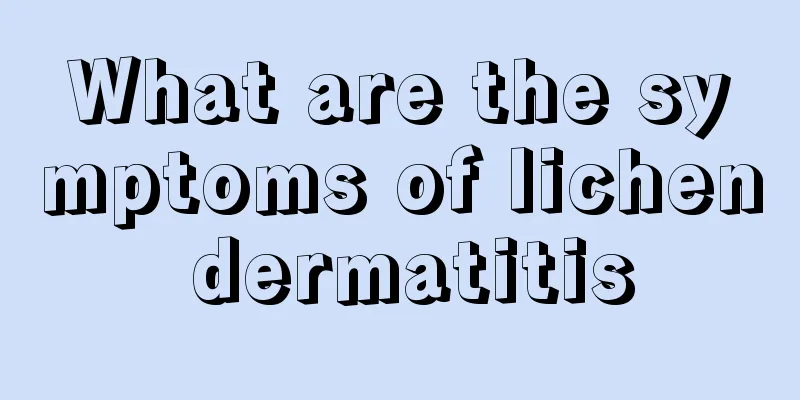What are the symptoms of lichen dermatitis

|
Lichen dermatitis is a neurodermatitis, which is similar to what Chinese medicine calls psoriasis. Both are paroxysmal itching. The inflammation of this disease will continue to worsen. Because of long-term scratching and friction, the patient's nerves become overly sensitive and are more sensitive to external stimuli. This disease often occurs in young and middle-aged people, and is more common in the elderly and children. After a chronic course of the disease, the symptoms are sometimes mild and sometimes severe. It is generally prone to occur in summer and can be relieved in winter. The symptoms will be alleviated during the calm period of the disease, and there will be no obvious surface symptoms. During the onset of the disease, it will lead to the expansion of local skin lesions. Long-term damage will gradually worsen, and obvious changes can be seen every day, from the initial local itching to the final damage to the skin surface. These have a great impact on people's bodies, so they should be coordinated with dietary conditioning and treatment in normal times. Symptoms and signs 1. It is more common in young and middle-aged people, and less common in the elderly and children. 2. It is a chronic disease, sometimes mild and sometimes severe, usually aggravated in summer and relieved in winter. The entire course of the disease can be divided into 3 stages: (1) In the quiescent phase, surface inflammation is mild or absent, the lesions are localized, and the boundaries are clear. (2) In the progressive stage, inflammation is obvious, infiltration is evident, lesions are enlarged, and the edges are blurred. (3) In the regression stage, the infiltration is mild, the lesions become thinner, and tend to heal. 3. From the perspective of distribution, the disease can be divided into two categories: localized and generalized. The most common sites are the sides of the neck (Figure 1), nape, forehead, followed by the sacrum, cubital fossa, and popliteal fossa. It can also be seen in the waist, back, hips, vulva, anus, groin, eyelids, scalp, limbs, etc. They are often distributed symmetrically and may be arranged in a linear manner along skin folds or cutaneous nerves. 4. Initially, local itching is felt, and the skin quickly becomes lichenified due to scratching. Typical lesions are mostly rice- to sorghum-sized, light red to yellowish brown or skin-colored, round or polygonal, hard, shiny, flat papules that are densely packed in patches, with a small amount of scales on the surface, accompanied by scratches and blood scabs. The lesions are most obvious in the center and become milder towards the edge with unclear boundaries. Over time, due to scratching, the skin becomes infiltrated and thickened with obvious ridges. If it occurs on the calf, the surface may become wart-like over time. Persistent scratching and rubbing of the shins or upper back can cause amyloid deposition in the dermis, which can lead to plaque and lichen amyloidosis, respectively. Long-term scratching may cause infection, such as folliculitis, furunculosis, etc. Diet and health care What foods are good for neurodermatitis? 1. Eat more fresh fruits and vegetables. 2. Eat foods that cool the blood and detoxify. Mung bean, rice, cucumber, bitter gourd, purslane, green tea, etc. What foods should not be eaten for neurodermatitis? (1) Avoid drinking stimulating beverages: such as tobacco, alcohol, strong tea, coffee, cocoa, etc. Because tobacco and alcohol are pungent and hot, they can move through the skin, generate heat and consume blood, making the blood hotter. At the same time, they can stimulate the cerebral cortex and produce high excitement, thus aggravating the condition. (2) Avoid spicy foods: such as onions, garlic, leeks, ginger, chili peppers, Sichuan peppercorns, pepper, cinnamon, star anise, cumin, curry, etc. Because these foods are pungent, dry, warm, and can stimulate wind and consume blood, they can aggravate blood heat and symptoms. At the same time, these foods also have a warming and stimulating effect, which can excite the cerebral cortex and make the mind agitated, thus aggravating the condition. (3) Avoid eating fishy or pungent foods, such as shrimp, crab, rooster, pork head, eel, roast chicken, and various grilled, fried, smoked or smoked foods. Because these foods easily accumulate moisture and produce nitrogen, which helps to increase heat and cause wind, they can aggravate rheumatic heat and thus worsen the symptoms of skin lesions. (4) Avoid taking any foods that replenish qi and blood, such as ginseng, deer antler, angelica, Cistanche deserticola, etc. Because these foods are warm and yang-replenishing, they can help heat generate wind, making the blood drier and making the disease more protracted and difficult to cure. |
<<: What are the causes and symptoms of tenosynovitis
>>: Is it okay to apply iodine tincture directly to the wound?
Recommend
How much does it cost to cure advanced lung cancer
How much does it cost to cure advanced lung cance...
Is lumbar tuberculosis contagious? The truth is this
Lumbar tuberculosis is a common type of tuberculo...
How to detect cervical cancer early
How to detect cervical cancer early? 1. Early sta...
What are the causes and pathologies of lung tumors?
The incidence and mortality of lung cancer are ri...
How to remove chewing gum from clothes
Many people have had this experience: chewing gum...
Seven details to help you see through the men of the 12 zodiac signs! Starting from the constellation
Detail 1: I don’t contact you every day If a Gemi...
What are the western medicines for lowering blood potassium?
Potassium is a trace element in the human body. I...
What is the normal value of uric acid? What should I do if my uric acid level is too high?
Uric acid has a certain normal value. Once it app...
Symptoms of atypical herpes
At present, some friends will suffer from a disea...
Young people have knee pain when it's cold
Young people, because of their young age, often t...
What is mild fatty liver
Fatty liver is a liver problem that many people h...
What foods can prevent esophageal cancer
Esophageal cancer is a type of cancer and one of ...
Symptoms and hazards of hyperkalemia
As the name suggests, hyperkalemia means that the...
What are the postures and times that are most conducive to pregnancy?
There are some couples in life who are always fac...
Gonorrhea DNA positive
The results of the gonococcal DNA test are positi...









